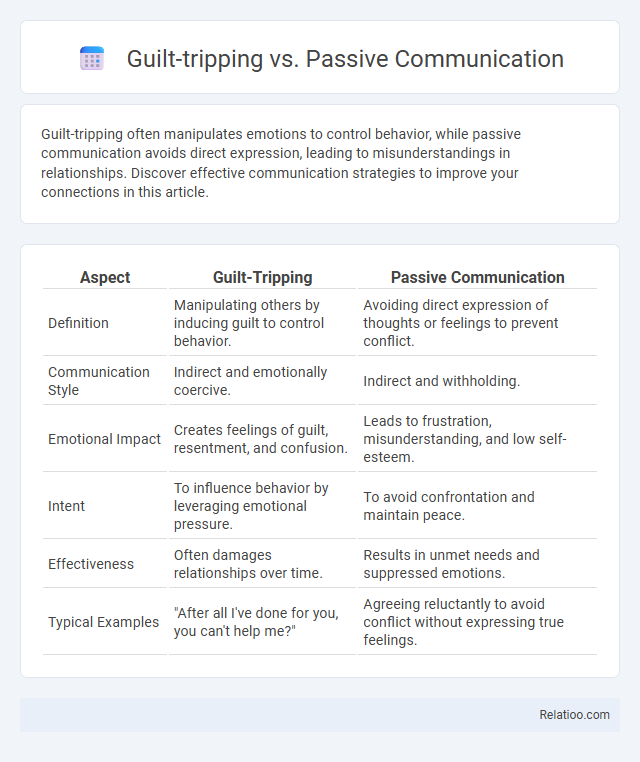Guilt-tripping often manipulates emotions to control behavior, while passive communication avoids direct expression, leading to misunderstandings in relationships. Discover effective communication strategies to improve your connections in this article.
Table of Comparison
| Aspect | Guilt-Tripping | Passive Communication |
|---|---|---|
| Definition | Manipulating others by inducing guilt to control behavior. | Avoiding direct expression of thoughts or feelings to prevent conflict. |
| Communication Style | Indirect and emotionally coercive. | Indirect and withholding. |
| Emotional Impact | Creates feelings of guilt, resentment, and confusion. | Leads to frustration, misunderstanding, and low self-esteem. |
| Intent | To influence behavior by leveraging emotional pressure. | To avoid confrontation and maintain peace. |
| Effectiveness | Often damages relationships over time. | Results in unmet needs and suppressed emotions. |
| Typical Examples | "After all I've done for you, you can't help me?" | Agreeing reluctantly to avoid conflict without expressing true feelings. |
Understanding Guilt-Tripping: Definition and Examples
Guilt-tripping involves manipulating someone by inducing feelings of guilt to influence their behavior, often through statements that imply blame or moral wrongdoing. Passive communication, in contrast, is characterized by indirect expression of feelings and needs, avoiding confrontation and often leading to misunderstandings. Recognizing guilt-tripping requires identifying phrases like "If you really cared, you would..." which contrast with passive communication's evasive or hesitant tone.
What Is Passive Communication? Key Traits
Passive communication is characterized by an inability to express your thoughts, feelings, or needs directly, often leading to misunderstandings and unmet expectations. Key traits include avoiding confrontation, yielding to others' preferences, and suppressing personal opinions to maintain harmony. This communication style contrasts sharply with guilt-tripping, which manipulates emotions to influence behavior, and more assertive forms of expression.
Psychological Impact: Guilt-Tripping vs Passive Communication
Guilt-tripping often triggers intense feelings of shame and lowered self-esteem, leading to increased anxiety and emotional distress, whereas passive communication typically results in unresolved conflicts and internalized frustration without overt emotional confrontation. The psychological impact of guilt-tripping can erode trust and foster resentment, while passive communication may cause confusion and diminished self-worth due to suppressed needs and unexpressed emotions. Both strategies undermine healthy communication but differ in their immediate emotional consequences and long-term relational effects.
Causes and Motivations Behind Each Style
Guilt-tripping stems from a desire to control or influence others by invoking feelings of responsibility or remorse, often rooted in unresolved personal insecurities. Passive communication arises from fear of confrontation or a need to avoid conflict, leading individuals to suppress their true feelings and indirectly express dissatisfaction. Both styles reflect underlying emotional needs: guilt-tripping seeks external validation through manipulation, while passive communication aims to maintain peace by withholding direct expression.
Recognizing Guilt-Tripping in Daily Interactions
Recognizing guilt-tripping in daily interactions involves identifying when someone manipulates emotions to induce feelings of responsibility or shame for their benefit, often using phrases like "After all I've done for you" or "You never care about me." Unlike passive communication, which is characterized by indirect or hesitant expression of needs, guilt-tripping actively exploits emotional leverage to influence behavior. Awareness of these subtle cues enables clearer boundaries and healthier interpersonal dynamics by preventing emotional manipulation.
Subtle Signs of Passive Communication
Subtle signs of passive communication include avoiding direct confrontation, using vague or indirect language, and suppressing true feelings, which often leads to misunderstandings and unresolved issues. Guilt-tripping manipulates emotional responses by implying blame, whereas passive communication masks your needs and opinions, making it difficult for others to understand or address your concerns. Recognizing these patterns empowers you to communicate more assertively and foster healthier relationships.
Consequences for Relationships and Mental Health
Guilt-tripping and passive communication both negatively impact relationships by fostering resentment and misunderstanding, yet guilt-tripping directly manipulates emotions, often leading to decreased trust and emotional distance. Passive communication can create confusion and unmet needs, escalating frustration and anxiety for both parties. Recognizing these patterns in your interactions is essential to maintaining healthy relationships and protecting your mental well-being.
Effective Strategies to Address Both Behaviors
Guilt-tripping and passive communication both undermine clear and healthy interactions by fostering resentment and confusion, which can damage relationships if not addressed properly. Effective strategies include establishing firm boundaries, using assertive communication techniques, and encouraging open dialogue to express feelings without manipulation or avoidance. By recognizing these behaviors early, you can create a more transparent and respectful communication environment that promotes mutual understanding and emotional well-being.
Setting Healthy Boundaries: Breaking the Cycle
Setting healthy boundaries involves recognizing and addressing guilt-tripping and passive communication patterns that undermine self-respect and autonomy. Clear, assertive communication enhances emotional clarity, reduces manipulation, and fosters mutual respect in relationships. Breaking the cycle requires consistent boundary enforcement and cultivating self-awareness to prevent guilt-driven compliance and passive responses.
Fostering Assertive and Respectful Communication
Guilt-tripping often manipulates emotions to influence behavior, while passive communication may lead to misunderstandings and unexpressed needs. Embracing assertive communication allows Your feelings and boundaries to be expressed clearly and respectfully, promoting mutual understanding and healthier relationships. Fostering assertive and respectful interaction reduces the negative impact of guilt-tripping and passive behavior, creating a space for honest, empathetic dialogue.

Infographic: Guilt-tripping vs Passive Communication
 relatioo.com
relatioo.com